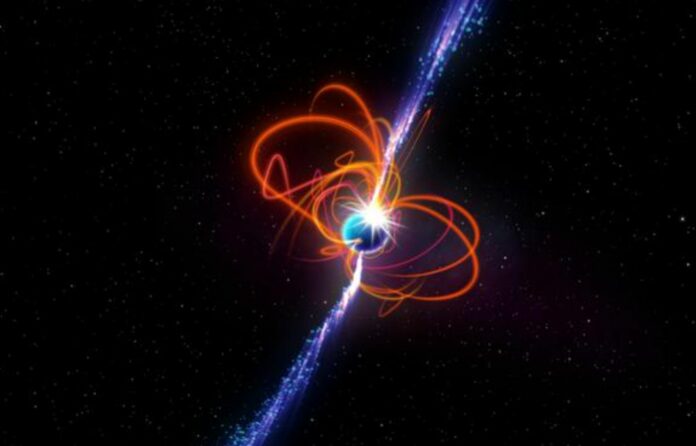It could be a rare type of magnetar, although for now, researchers are not sure about its true nature.
An international collaboration spearheaded by astronomers from the Curtin University’s International Centre for Radio Astronomy Research (ICRAR) node has unveiled a novel celestial entity that provokes us to reconsider our comprehension of neutron star physics.
This newly found object might be a magnetar with an extremely long rotation period, an uncommon class of stars that possess immense magnetic fields and can emit potent energy outbursts.
Previously, the emission of energy from all identified magnetars was observed at intervals from a few seconds to several minutes. However, this recently discovered object transmits radio signals every 22 minutes, setting a new record for the longest rotation period observed in a magnetar.
The findings of this research were reported today in the Nature Journal.
Using the Murchison Widefield Array (MWA), a radio telescope located in the rural Wajarri Yamaji Country in Western Australia, the astronomers located the celestial body.
The lead researcher, Dr. Natasha Hurley-Walker, mentioned that this magnetar, dubbed GPM J1839−10, is situated 15,000 light-years from Earth in the Scutum constellation.
She said, “This remarkable object challenges our understanding of neutron stars and magnetars, which are some of the most exotic and extreme objects in the Universe.”
This star is the second such discovery, with the first found by Curtin University undergraduate research student Tyrone O’Doherty.
Scientists were initially unable to comprehend the nature of their discovery.
A paper describing a mysterious transient object was published in Nature in January 2022. This object would intermittently materialize and vanish, emitting potent energy beams three times every hour.
Dr. Hurley-Walker, who was O’Doherty’s mentor, mentioned the surprise the first discovery brought.
“We were stumped,” she remarked. “So we started searching for similar objects to find out if it was an isolated event or just the tip of the iceberg.”
From July to September 2022, the team surveyed the skies utilizing the MWA telescope and eventually discovered GPM J1839−10.
It releases energy outbursts that endure up to five minutes—five times longer than the first entity.
The discovery was corroborated and further examined by other telescopes to understand the entity’s unique traits.
These included three CSIRO radio telescopes in Australia, South Africa’s MeerKAT radio telescope, the Grantecan (GTC) 10m telescope, and the XMM-Newton space telescope.
With the celestial coordinates and characteristics of GPM J1839−10, the group also started to sift through observational archives from leading global radio telescopes.
“It showed up in observations by the Giant Metrewave Radio Telescope (GMRT) in India, and the Very Large Array (VLA) in the USA had observations dating as far back as 1988,” she explained.
“That was quite an incredible moment for me. I was five years old when our telescopes first recorded pulses from this object, but no one noticed it, and it stayed hidden in the data for 33 years.
“They missed it because they hadn’t expected to find anything like it.”
Not all magnetars emit radio waves. Some are located beneath the ‘death line,’ a crucial boundary where a star’s magnetic field is too feeble to generate high-energy emissions.
“The object we’ve discovered is spinning way too slowly to produce radio waves—it’s below the death line,” noted Dr. Hurley-Walker.
“Assuming it’s a magnetar, it shouldn’t be possible for this object to produce radio waves. But we’re seeing them.
“And we’re not just talking about a little blip of radio emission.
“Every 22 minutes, it emits a five-minute pulse of radio wavelength energy, and it’s been doing that for at least 33 years.”
The mechanism driving this “is extraordinary.”
The discovery carries significant implications for our understanding of neutron star physics and magnetic field behavior in extreme conditions.
It also opens up fresh inquiries about the creation and evolution of magnetars and might help unravel the origins of elusive phenomena such as fast radio bursts.
The research team intends to conduct more observations of the magnetar to gain insights into its properties and behavior.
They also aim to identify more of these puzzling entities in the future, to establish whether they truly are ultra-long period magnetars, or something even more extraordinary.
Image Credit: ICRAR
